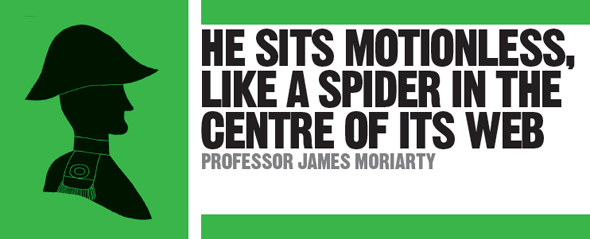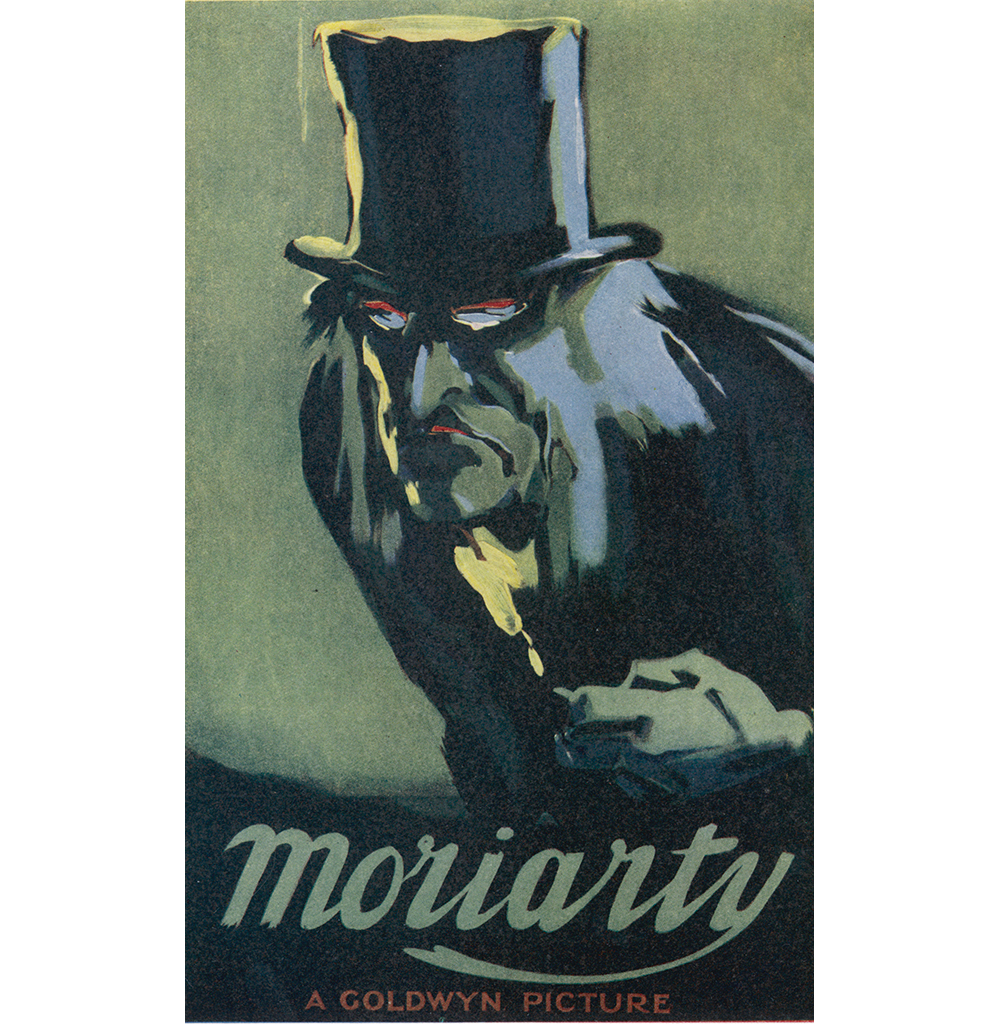
Conan Doyle created Professor James Moriarty simply to provide a fitting opponent with whom his hero could grapple during his goodbye to the world in “The Final Problem”. Although Moriarty apparently died after his brief, dramatic encounter with Holmes at the Reichenbach Falls in Switzerland, and he only appears directly in one other story, The Valley of Fear—set earlier in Holmes’s career—his powerful specter seems to haunt the later tales. The character of Moriarty became established in readers’ minds, and today we can hardly talk of Holmes without mentioning his nemesis—Moriarty is forever linked to the great detective’s legacy.

Sidney Paget’s illustration of Moriarty first appeared in “The Final Problem,” which was published in the December 1893 edition of The Strand Magazine.
Holmes’s equal
The professor’s power to terrify may stem from the fact that he is a mirror image of Holmes: the man the great detective might have become had he chosen to follow a sinister path. Moriarty is a spine-chilling version of Holmes: both men have high foreheads and sharp eyes, but in Moriarty’s case everything is more drawn and exaggerated. Tall and thin, with sunken eyes and a protruding chin, his head moves from “side to side in curiously reptilian fashion.” Moriarty came from a privileged background and received an excellent education that set him on a path toward respectability. Naturally brilliant at mathematics (a subject Conan Doyle hated), at the age of 21 he wrote a treatise on algebra that achieved recognition throughout Europe. He was also celebrated for his brilliant book on the dynamics of asteroids, which Holmes remarks is so advanced that “no man in the scientific press was capable of criticising it.” On the back of this work, Moriarty became a professor of mathematics at an English university. But then unspecified “dark rumours” began to circulate about him, and he relocated to London to begin his criminal career. And what a career it was. Moriarty became the ultimate mastermind, drawing on his prodigious intellect to run a vast crime network, the largest ever seen, and yet remain invisible at its heart, entirely above suspicion, as the Professor Moriarty of mathematical celebrity. “Like a spider,” he sat at the center, pulling the strings of this criminal web—“the organizer of half that is evil and of nearly all that is undetected in this great city.” It took the equal genius of Holmes to finally trace the threads back to him.

Released in 1922, the movie Moriarty (originally titled Sherlock Holmes in the US) starred German actor Gustav von Seyffertitz as the brilliant criminal mastermind Professor Moriarty.
Brain of the underworld
The brilliance of Moriarty’s schemes means that no one can ever pin down the source of his criminal gains, whether it is burglary, extortion, or forgery. Holmes likens him to Jonathan Wild, who in the 18th century “was a master criminal… the hidden force of the London criminals, to whom he sold his brains and his organization on a fifteen per cent commission.” Wild pretended to be a thief-taker, earning fame and money for the way his network caught criminals—but it was also he who was organizing the crime. Holmes scholars have identified various other candidates who may have provided Conan Doyle with the inspiration for Moriarty, but by far the strongest is the true-life criminal genius Adam Worth. Indeed, the similarity in their methods is so marked that the US detective William Pinkerton, head of the famous Pinkerton Detective Agency, believed that Conan Doyle should pay him royalties, as he had told the author all about Worth during a transatlantic voyage.
There are two major clues that lend weight to this theory. Firstly, in “The Final Problem” Moriarty is referred to as the “Napoleon of crime”—a moniker that was coined for Adam Worth. Secondly, in The Valley of Fear, Holmes reports that the professor has hanging in his study an incredibly valuable, and famous, painting of a coquettish young woman that he could only have acquired through theft. It is easy to believe that this is Conan Doyle’s reference to Worth’s temporary “ownership” of Thomas Gainsborough’s alluring portrait of Georgiana, Duchess of Devonshire, which he had personally cut from its frame in the gallery in which it was hanging, having reportedly become smitten with it.
"The greatest schemer of all time, the organiser of every devilry, the controlling brain of the underworld, a brain which might have made or marred the destiny of nations—that’s the man!"
Sherlock Holmes
ADAM WORTH

German-born American super- criminal Adam Worth (1848–1902) was dubbed the “Napoleon of crime” by Scotland Yard’s Robert Anderson for his skill in running a major crime network from his home in London. Like Moriarty, Worth was an expert operator, staying at arm’s length from his crimes; unlike Moriarty, however, he was opposed to the use of violence, and treated the men who worked for him as family. Indeed, the only reason he finally served a prison term (for petty crime) was because he got caught while going to the aid of one of his gang. Worth began his life of crime in the US, as a bank robber, before moving to London to set up as a respectable art collector and the head of a criminal syndicate involved in robbery and forgery.
For years, he outfoxed the world’s police by conducting bloodless, well-executed crimes without leaving a shred of incriminating evidence. For example, there was nothing to link him to his theft of a Thomas Gainsborough artwork, which he carried with him for 25 years before shrewdly negotiating a $25,000 fee for its return.
